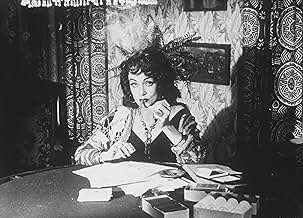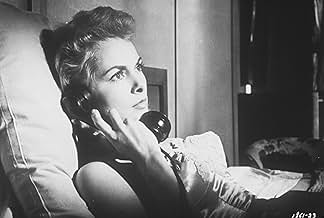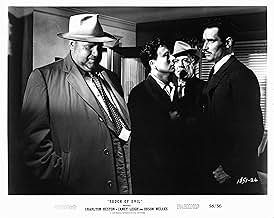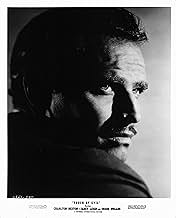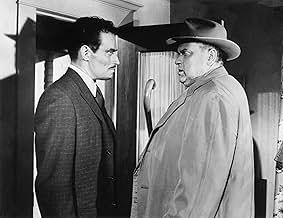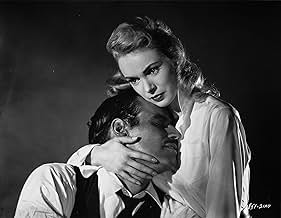Une histoire brutale et perverse de meurtre, d'enlèvement et de corruption policière dans une ville frontalière du Mexique.Une histoire brutale et perverse de meurtre, d'enlèvement et de corruption policière dans une ville frontalière du Mexique.Une histoire brutale et perverse de meurtre, d'enlèvement et de corruption policière dans une ville frontalière du Mexique.
- Réalisation
- Scénario
- Casting principal
- Récompenses
- 7 victoires et 1 nomination au total
Valentin de Vargas
- Pancho
- (as Valentin De Vargas)
Avis à la une
Seldom have I seen so many comments with so little understanding. The movie is not about Heston's "Mexican-ness" or lack of it. The movie is not about the 5 or 8 or 10 minute opening shot. The movie is not even, god help us, about Welles' descent from the heights into "slumming it" in a "Grade B" flick.
The movie is about two things : film-making, and character. Every shot worth remembering (and there are few that aren't) is an exercise in the possibilities of film, particularly black and white film. Woody Allen makes movies in black and white that are all conversation. Welles made movies in black and white because that's where the colors of the characters, the location and ultimately the meaning of the movie are possible. Black and white film is about the infinite possibilities of shadow. Touch of Evil is about the infinite possibilities of human nature.
Heston, for those of you who just can't see past a "bad" accent is about rigidity and short-sightedness. What kind of idiot would leave his wife in all those threatening situations? The kind of idiot who can't imagine that anyone would harm HIS wife, simply because she IS his wife! Akim Tamiroff's Grandi is about flexibility to the point of breakage. Always playing ALL ends against the middle he is the essence of "harmless" corruption, that ultimately harms everyone.
And Welles' Hank Quinlan ... I just don't have the time or space to explain that Quinlan is about the true cost of police work when the humanity has gone out of it. Ultimately Quinlan would kill his best and only friend, the only one, as Dietrich has it, who really loves him. At one time, perhaps, Quinlan WAS the image that Pete Menzies saw. But the man behind that image was eaten up long ago with alcohol and frustrated grief. It's all about winning and losing now, and things he would never do. Until he does them.
There are so many other moments and characters that I'm afraid you'll just have to watch the film with your eyes and your mind open instead of shut to "get it". Pay attention to what's on the screen instead of the smart, cynical, hip comments you can make about an actual work of heart.
Well, what the hell. Joan Didion said it best. Film criticism is petit point on kleenex.
Raoul Duke
The movie is about two things : film-making, and character. Every shot worth remembering (and there are few that aren't) is an exercise in the possibilities of film, particularly black and white film. Woody Allen makes movies in black and white that are all conversation. Welles made movies in black and white because that's where the colors of the characters, the location and ultimately the meaning of the movie are possible. Black and white film is about the infinite possibilities of shadow. Touch of Evil is about the infinite possibilities of human nature.
Heston, for those of you who just can't see past a "bad" accent is about rigidity and short-sightedness. What kind of idiot would leave his wife in all those threatening situations? The kind of idiot who can't imagine that anyone would harm HIS wife, simply because she IS his wife! Akim Tamiroff's Grandi is about flexibility to the point of breakage. Always playing ALL ends against the middle he is the essence of "harmless" corruption, that ultimately harms everyone.
And Welles' Hank Quinlan ... I just don't have the time or space to explain that Quinlan is about the true cost of police work when the humanity has gone out of it. Ultimately Quinlan would kill his best and only friend, the only one, as Dietrich has it, who really loves him. At one time, perhaps, Quinlan WAS the image that Pete Menzies saw. But the man behind that image was eaten up long ago with alcohol and frustrated grief. It's all about winning and losing now, and things he would never do. Until he does them.
There are so many other moments and characters that I'm afraid you'll just have to watch the film with your eyes and your mind open instead of shut to "get it". Pay attention to what's on the screen instead of the smart, cynical, hip comments you can make about an actual work of heart.
Well, what the hell. Joan Didion said it best. Film criticism is petit point on kleenex.
Raoul Duke
Considered by many to be the last "classic" noir film ever made, and perhaps the last masterwork from child prodigy Orson Welles, who looks about sixty in this film, despite his 42 years. In TOUCH OF EVIL the "noirish" dark streets and shadows are darker than ever, practically swallowing up the soft tones like a murky swamp. The action takes place in a nondescript U.S./Mexico border town where the worst that both sides has to offer is most in evidence. The famous opening scene (a 3 1/2-minute continuous shot) where we witness a time bomb being placed in the trunk of a Cadillac is masterful. The camera pulls in and out of the city scene as it follows the motion of the vehicle winding its way through streets littered with pedestrians, thus effectively creating a level of anxiety that could not be duplicated with multiple edits. After the inevitable explosion, the drama dives into a seedy world of corrupt police justice and malevolent decrepitude, which is filmed with such a stylish flair, it is almost weirdly humorous and playful! Mike Vargas, the good guy, is played by Charlton Heston and seems more than a wee bit miscast as a Mexican narcotics officer with his face darkened by makeup. When U.S. Police Captain Hank Quinlan (Orson Welles) first meets him he remarks, "He doesn't look Mexican." Quinlan is the ultimate repugnant cop gone bad and Welles has the camera looking up into his nostrils most of the time making his character look even more monstrous. But Quinlan is also pitifully sad. A man who once had the instincts of a cat and the intelligence of a fox has been reduced to an insignificant mass of tissue, who's "instinct" is having a knack for finding evidence that he himself has planted. And while he may be revered by the local officials in law enforcement, he's acutely aware that he is a fraud and petrified that Vargas, has seen him naked.
When anyone mentions this masterpiece they usually make some ignorant remark about Charlton Heston not being believable as a Mexican. Apparently such people think all Mexicans resemble the ones they've seen in the US who are mostly mestizo - 60% of Mexicans are Mestizo, 30% Indian and about 10% European. Well, Mexico's ruling class is predominantly of European ethnicity, and today many are educated in the US and so they speak fluent English with an American accent. Charlton Heston is playing a man who is a member of that elite and is thus believable in the role in terms of his physical appearance and possibly even his accent. The only problem came when his character had to speak Spanish! Now there he had a problem...
Touch of Evil has, perhaps, the BEST cinematography and lighting in ANY film ever made. Not just in the film noir genre, but in all categories. Orson Welles tended to use wide shots for all of his films, and Touch of Evil's use of wide shots took filmmaking to another level, especially with the amazing opening shot. The camera techniques and lighting are too spectacular to fathom, it is the grandmaster of all movies. Brilliant is an understatement. See this film, if not for the excellent acting and sheer brilliance in terms of the camera (this film had a GREAT D.P.!!), but for entertainment value. But if you are a film student or just want to see great camera work, Touch of Evil will astonish you.
10Dr.Teeth
There are only two ways to write a review that would truly do this film justice. Either one would have to write an exceedingly long review, or a short, concise one. I choose to do the latter.
When I first saw "Touch of Evil," I was glued to the chair. When I found out it was not Welles' definitive vision, I wondered how on earth it could have been made better. And when I saw the re-released version, I wondered why the studio altered it. The stunning black-and-white images, the intricate plot, and the powerful, engaging performances took a hold of my imagination. At times, I imagined myself on the street with the characters, because the atmosphere was so thick I felt surrounded in it.
The actors all did an outstanding job, especially Leigh and Heston (who, although not thoroughly convincing as a Mexican, soared above his usual powerful, furious presence). This is Welles' picture, however, and whenever the camera catches his obese figure, you are fully aware of the man as a director and an actor. His powerful vision drives the film, from the single-cut opening sequence to the cat-and-mouse finale.
I suggest watching the 1998 restored version over the original theatrical release, but regardless of which version, "Touch of Evil" will have you stuck in your seat, questioning your views of morality until long after the last credit has rolled up the screen.
When I first saw "Touch of Evil," I was glued to the chair. When I found out it was not Welles' definitive vision, I wondered how on earth it could have been made better. And when I saw the re-released version, I wondered why the studio altered it. The stunning black-and-white images, the intricate plot, and the powerful, engaging performances took a hold of my imagination. At times, I imagined myself on the street with the characters, because the atmosphere was so thick I felt surrounded in it.
The actors all did an outstanding job, especially Leigh and Heston (who, although not thoroughly convincing as a Mexican, soared above his usual powerful, furious presence). This is Welles' picture, however, and whenever the camera catches his obese figure, you are fully aware of the man as a director and an actor. His powerful vision drives the film, from the single-cut opening sequence to the cat-and-mouse finale.
I suggest watching the 1998 restored version over the original theatrical release, but regardless of which version, "Touch of Evil" will have you stuck in your seat, questioning your views of morality until long after the last credit has rolled up the screen.
Le saviez-vous
- AnecdotesJanet Leigh's agent initially rejected her participation in this film due to the low salary offered without even consulting the actress. Orson Welles, anticipating this, sent a personal letter to the actress, telling her how much he looked forward to their working together. Leigh, furious, confronted her agent telling him that getting directed by Welles was more important than any paycheck.
- GaffesThe car that blows up four minutes into the film has the Texas plate AG 3724; 32 minutes into the film, police car number 10 also has the Texas plate AG 3724.
- Crédits fousOpening statement (restored version): In 1957, Orson Welles completed principal photography on TOUCH OF EVIL and edited the first cut. Upon screening the film, the Studio felt it could be improved, shot additional scenes and re-edited it. Welles viewed this new version and within hours wrote a passionate 58-page memo requesting editorial changes. This version represents an attempt to honor those requests and make TOUCH OF EVIL the film Orson Welles envisioned it to be. "... I close this memo with a very earnest plea that you consent to this brief visual pattern to which I gave so many long hard days of work." -- Orson Welles
- Versions alternativesA new version, running 111 minutes, has been restored by Universal and debuted at the Telluride Film Festival in September 1998. This version has been re-edited according to Orson Welles' original vision, as outlined in a 58-page memo that the director wrote to Universal studio head Edward Muhl in 1957, after Muhl took editing out of Welles' hands. The new version has been prepared by editor by Walter Murch, sound recordists Bill Varney, Peter Reale and Murch, and picture restorer Bob O'Neil under the supervision of Rick Schmidlin and film critic Jonathan Rosenbaum. One difference between the two versions is that the famous opening tracking shot is now devoid of credits and Henry Mancini's music, featuring only sound effects.
- ConnexionsEdited into American Cinema: Film Noir (1995)
- Bandes originalesMain Title (Touch of Evil)
Written by Henry Mancini
Performed by United International Orchestra;
Rolly Bundock (bass); Shelly Manne (drums); Barney Kessel (guitar); Jack Costanzo, Mike Pacheco (percussion); Ray Sherman (piano); Dave Pell (baritone sax); Plas Johnson (tenor sax)Conrad Gozzo, Pete Candoli, Ray Linn (trumpets) ;Red Norvo (vibes)
Meilleurs choix
Connectez-vous pour évaluer et suivre la liste de favoris afin de recevoir des recommandations personnalisées
Détails
- Date de sortie
- Pays d’origine
- Langues
- Aussi connu sous le nom de
- Sed de mal
- Lieux de tournage
- El Rancho Courson Motel, SW corner of E Barrel Springs Rd and Courson Ranch Road, Palmdale, Californie, États-Unis(Mirador Motel - now site of a residential cul-de-sac)
- Société de production
- Voir plus de crédits d'entreprise sur IMDbPro
Box-office
- Budget
- 829 000 $US (estimé)
- Montant brut aux États-Unis et au Canada
- 2 247 465 $US
- Week-end de sortie aux États-Unis et au Canada
- 70 725 $US
- 13 sept. 1998
- Montant brut mondial
- 2 285 063 $US
- Durée1 heure 35 minutes
- Couleur
Contribuer à cette page
Suggérer une modification ou ajouter du contenu manquant



